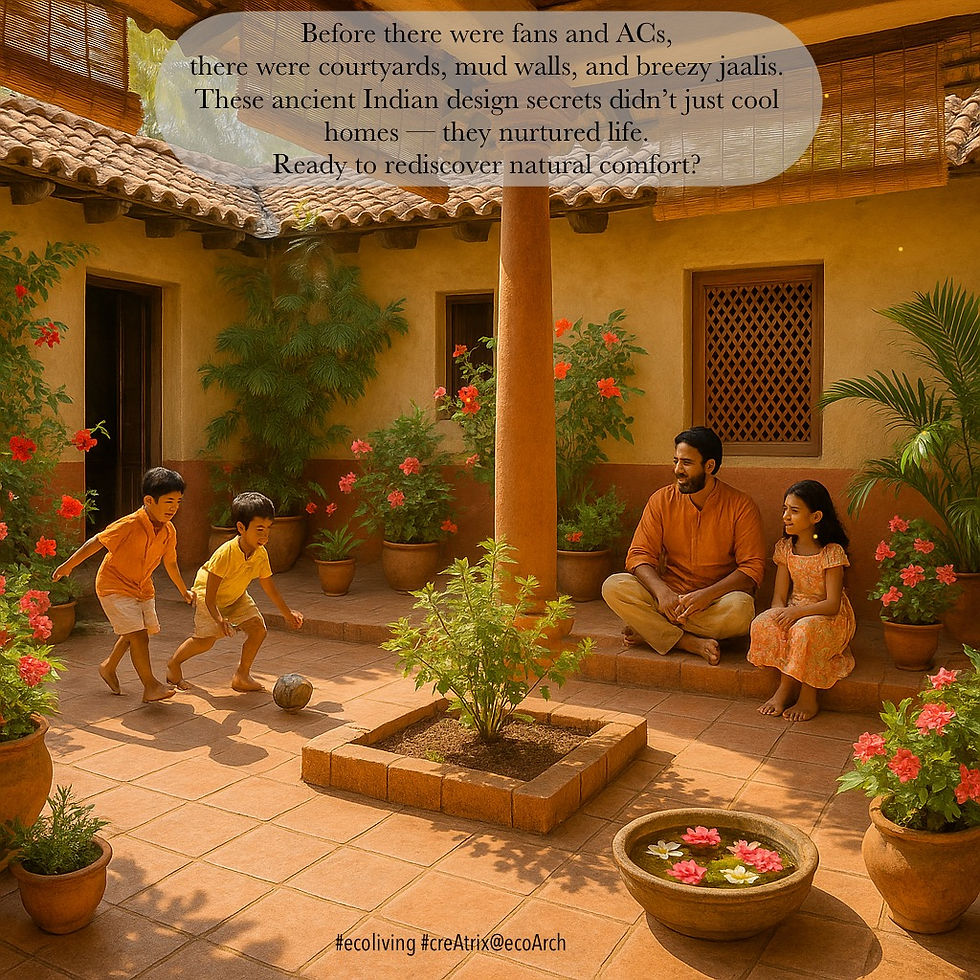3 Ancient Indian Cooling Methods That Still Work Like Magic: Modern comfort, rooted in timeless wisdom.
- Supriya B.S
- Jun 16
- 2 min read
Introduction:
Picture this.
It’s midsummer. The air feels still, but step into your grandmother’s courtyard and it’s instantly cooler. No AC. No fans blasting. Just a soft breeze, scent of earth, and shade that hugs you.
That’s not nostalgia — it’s architecture working in harmony with nature.
India has always had answers for climate-smart living. Our ancestors didn’t just build homes — they crafted sanctuaries that cooled, calmed, and healed.
Today, I’m bringing back 3 such ancient Indian cooling methods that still work — and can be woven into modern ecological homes.
The Courtyard Effect (Aangan Logic)
Inward-facing homes with an open courtyard were common in traditional Indian architecture.
Why?
Because the courtyard:
✔ Pulls hot air up and out
✔ Encourages vertical airflow
✔ Keeps the heart of the home shaded and breezy
Real-life inspiration:
The Chettinad mansions in Tamil Nadu or old haveli homes in Rajasthan all embraced this layout — naturally ventilated, self-cooling, and incredibly grounding.
Modern Take: Even a small skylit atrium or internal garden can bring this cooling magic into today’s urban homes.
Terracotta, Lime & Mud — Nature’s Own AC Team
Before concrete ruled the world, homes were made from breathable materials like:
Terracotta tiles – which reflect heat
Lime plaster – which resists moisture and stays cool
Mud walls – which absorb daytime heat and release it at night
These materials regulate temperature like a pro — naturally!
Modern Take: Use lime plasters for interiors, terracotta jaalis for facades, or even mud flooring in shaded patios. You’ll feel the difference under your feet.
Jaalis & Chiks — The Art of Filtering Sun + Air
Ancient builders didn’t block sunlight — they filtered it.
Jaalis (lattice screens) and bamboo chiks (roll-up blinds) allowed soft air and dappled light to flow through while keeping harsh heat out.
The result?
Cool, breezy interiors with zero electricity used.
Modern Take: Try installing terracotta jaalis on west-facing walls or bamboo blinds on balconies. They’re aesthetic and effective.
Why This Matters Today
In an age of rising heatwaves and energy bills, these age-old solutions are not just poetic — they’re practical.
Rooted in sustainability, tuned to climate, and deeply soulful, these methods offer a path to build cool homes without cooling the planet.
Ready to Redesign with Nature?
I help individuals, resorts, institutions, and businesses design ecological spaces that breathe and heal.
Let’s bring back ancient wisdom — with a contemporary twist.
📩 Book a free 15-minute discovery call
Website - www.creatrixarchitects.com
🔁 Found this useful? Share it with someone who’s sweating through summer.
#ecoliving #creAtrix@ecoArch #

SustainableArchitecture #IndianDesignWisdom #PassiveCooling #VastuInspiredDesign #EcologicalHomes #ConsciousLiving #ArchitectureWithSoul



Comments